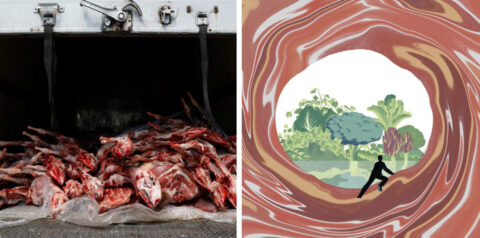News
Costco Chicken Processing Plant Keeps Failing Tests for Salmonella
Food•5 min read
Perspective
Mainstream media refuses to document the food system truthfully and accurately. It’s our responsibility to hold them accountable.

Perspective • Food • Industry

Words by Taylor Meek
On May 21, 2020, The New York Times published an opinion piece titled “The End of Meat Is Here” written by Jonathan Safran Foer, author of Eating Animals and We Are the Weather. As if the headline and general topic were not shocking enough, the article debuted an image displaying something that is typically neglected by the media—animal slaughter. “Meat piled in a delivery truck in Manhattan on May 9” was the description under the image by Andrew Kelly of Reuters.
The article was shared thousands of times across social media platforms and was trending on Twitter. A tweet by The New York Times—showing a butchered piece of meat as the preview image—has accrued over 16,000 likes and over 10,000 retweets thus far. Animal advocates and meat industry watchdogs responded empathically.
https://twitter.com/JayShooster/status/1263486130495905792
Deena Shanker, a food reporter for Bloomberg, also applauded the Times’ image selection, tweeting: “while I don’t expect meat consumption to significantly drop from COVID19, I have to say, images like this—with eyes-in carcasses—in a major paper are unusual, so kudos to the NYT for showing the reality of how animals become meat.”
But that was before the image changed. Less than 24 hours after the op-ed was published, the Times swapped out the featured image for a less gory, more abstract illustration depicting a human figure emerging from a swirling mess of meaty sinews into a green, grassy pasture. Overlooking the online success of the initial image, the Times went ahead and printed the new image in its Sunday paper, which is distributed to more than a million subscribers around the world.
Whether the Times editor decided to change the image because they received a specific complaint or because the story’s traffic numbers were down remains unclear. What we do know is that changing the image fundamentally changes the story: from a scathing critique that the food system is failing to a haphazard warning that the meat industry, as we know it, might be coming to an end. Although Foer’s text was unchanged, there is no question that the new image, at first glance, softens the story. If we’ve learned anything from the Times’ approach to visual storytelling, it’s that burgers, animal parts, and other processed meats can make the headlines, but a pile of bloodied food animals—with eyes still on their bodies—will not.
An abstract illustration is no doubt more palatable and without questions misses, or at least obscures Foer’s point: “We cannot protect against pandemics while continuing to eat meat regularly. Much attention has been paid to wet markets, but factory farms, specifically poultry farms, are a more important breeding ground for pandemics. Further, the C.D.C. reports that three out of four new or emerging infectious diseases are zoonotic—the result of our broken relationship with animals.”
Leaning on strong, structured evidence, Foer asks readers to take a step back and review their lifestyle choices. Bari Weiss, the Times’ opinion editor, even took to Twitter to acknowledge her new outlook: “I love burgers. Love. But working on this piece reminded me of what I try to avoid: eating them comes with too high a cost. Renewing efforts to wean myself off meat.” This probably holds true for most of us. Research shows that consumers understand the ethical, environmental, or health issues associated with eating meat but do their best to suppress these facts out of convenience, cost, or habit.
The animal agriculture industry is rife with disinformation. But never has the information gap between producers and consumers been more apparent than during the current crisis. According to Sentient Media’s latest research, most mainstream media outlets neglect to report on the connection between COVID-19 and the human exploitation of nonhuman animals.
Covering the mayhem of packed hospitals, barren grocery store shelves, and rising death counts makes for more relatable news headlines than unveiling the uncomfortable truths residing within our global food system. The current lack of reporting on the zoonotic origins of the coronavirus in the news is so severe that we know almost as little about wet markets in Asia as we do factory farms in America. In fact, only 10 to 20 percent of people in the U.S. understand the animal-based origins of the virus.
Let’s be clear: The COVID-19 outbreak was caused by humans. Without a demand for wildlife products, we would not have the novel coronavirus. Unless we start reporting on the true cause of this pandemic and its implications for animal agriculture, we’ll never be able to make the changes necessary to prevent the next outbreak.
Beginning in March, we surveyed five of the largest journalism organizations in the world—NPR, BBC, The Guardian, The Washington Post, and The New York Times—to find out how they’re reporting on coronavirus.
We specifically looked for mentions of the words “animal” and “origin” in trend stories and overview pieces about the pandemic, as both reflect the kind of comprehensive coverage that should mention COVID-19’s animal link.
What we found is that while at the time roughly 70 percent of the articles we surveyed explained where the virus originated, often using sparse language like “it came from animals,” very few made the connection to the cause of the outbreak. Only 15 out of the 50 most popular articles we surveyed accurately explained humans’ culpability in the spread of the virus.
Along with media coverage, we monitored the social media accounts of three top news organizations—The New York Times, The Washington Post, and HuffPost—to better understand their potential impact on the publics’ understanding of COVID-19’s origins. According to a 2019 Pew Research Center study, over half of American adults consume the majority of their news from social media.
These three news outlets have the combined potential to reach over 116 million people—around two-thirds of the U.S. population—across Twitter, Facebook, and Instagram. After reviewing their social channels, we found that the presence of wildlife market imagery and photos of factory farms, which could be harboring the next pandemic much closer to home, was nearly non-existent.
[infogram id=”potential-reach-of-covid-19-news-on-social-1h0r6r9j78d76ek?live”]
Mainstream media has the potential to reach millions, even billions of people around the globe each day through print and online articles, blogs, and social media. The public trusts these outlets to report the whole truth and operate in their best interests, but that is not always the case. As we have seen with COVID-19 coverage, these outlets are neglecting to show the main reason why we are in this pandemic in the first place. Documenting animal exploitation within our food system is difficult but necessary if we want the public to understand how to prevent the next outbreak.
The New York Times has over 70 million followers across Facebook, Instagram, and Twitter. NYT has covered wet markets on its website, but their social media platforms are lacking in photos that show Asia’s wet markets and more specifically, photos of the animals being bought and sold at these markets. In 2006, NYT suggested visiting wet markets as a tourist destination.
The Washington Post has 23 million followers across the same three platforms. Not only are images of wet markets neglected on WashPo’s social channels, but the website’s overall coverage of wet markets is thin. One article mentions the plummeting chicken prices in India, as many consumers are no longer purchasing meat from wet markets, but not a single photo of wet markets is present. An article about the Chinese food system’s role in pandemic prevention seemed promising, but instead of gruesome wet market photos, the article displays three grinning men holding live goats in their arms. This image far from captures the fear, confusion, and pain animals endure inside wet markets.
HuffPost has over 11 million followers on Twitter alone and more than 23 million across all three major platforms. Unsurprisingly, on HuffPost’s social media channels, there is a severe lack of multimedia reporting on wet markets. Their Instagram page shows no visible representation of farmed animals whatsoever (although there are plenty of penguins, llamas, and cats). If you search “wet markets” on HuffPost’s website, the lack of search results is also concerning. One article mentions wet markets, and even provides a photo of seafood being sold—which is commendable—but the image does not fully capture the disarray of Asia’s wildlife markets.
The need for honest, fact-driven news coverage has never been greater. What is being made rapidly apparent during the pandemic is that the need for news monitoring is just as great. Over the past three months, most major news outlets have failed to cover COVID-19’s animal angle responsibly. It’s up to us to hold them accountable for the spread of inaccurate or incomplete information about the overwhelming threat the factory farming industry poses to public health and the stability of the global food supply chain before the next virus hits.